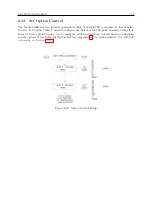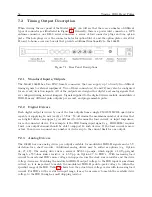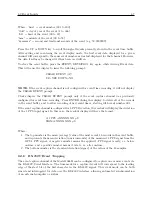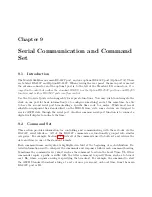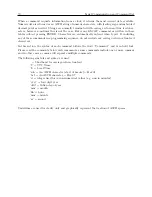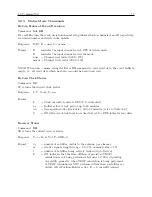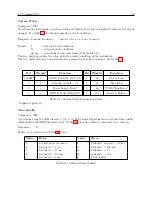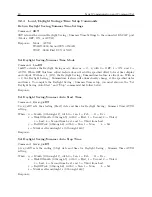
68
Relay Contacts and Event Inputs
To perform event trapping via the RS-232C interface, the circuit must first be ARMED; that is,
made ready to receive an event trigger. Only one event may be captured after every arming, but
the events are stored sequentially in the event buffer in exactly the same manner as the normal
event time mode, thereby allowing up to 200 events to be recorded.
8.2.9
Event Trapping Setup
Configuring the clock to trap events (incoming data) on the RS-232C interface requires making the
configuration changes described in Section 5.2.2.
Arm the Event-Trapping circuit from the front panel using the SET RS-232 sub-menu from the
SETUP key. This menu also provides for configuration of communications port parameters (e.g.
baud rate, word length, etc.) to match those of the computer or equipment to be interfaced. The
following steps are required to arm the Event Trapping circuitry from the front panel:
1. Press the following keys in order; SETUP
>
ENTER
>
SETUP
>
SETUP. The display
should indicate the following:
SET
A EVENT?
2. Press ENTER again and the display should indicate the following:
ARM
A EVENT?
PRESS ENTER TO ARM
3. Press the ENTER button and the Event Input should be armed.
When the event occurs on the RS-232C port (i.e. the start bit of the next received character), the
event data can be reviewed in the event mode exactly as any normally captured event would be. To
capture further events, the circuit must be re-armed from the front panel or by using the RS-232
Command “AR.”
Note that received commands are viewed as complete when the final character in the command is
received. Control characters, such as carriage-return and line-feed, are ignored and may follow the
“AR” command, but the start bit of the next character after the “R” (even if a carriage return)
may trigger the event timer. For a complete list of RS-232C Event Mode commands, refer to
Section 9.2.2.
Summary of Contents for 1088A
Page 4: ...iv ...
Page 6: ...vi ...
Page 18: ...xviii LIST OF FIGURES ...
Page 23: ...1 4 Attaching Rack Mount Ears to 1088A B Series Clocks 3 Figure 1 2 Attaching Rack Mount Ears ...
Page 24: ...4 Unpacking the Clock ...
Page 32: ...12 Front and Rear Panels ...
Page 38: ...18 Connecting Inlet Power Input and Output Signals ...
Page 46: ...26 GPS Antenna and Cable Information ...
Page 48: ...28 Setting Internal Jumpers Figure 5 1 Model 1088B Main Board ...
Page 76: ...56 The Setup Menus ...
Page 112: ...92 Serial Communication and Command Set ...
Page 127: ...B 4 Physical Dimensions 107 Figure B 1 Suggested Mounting of the AS0094500 Surge Arrester ...
Page 128: ...108 Using Surge Arresters ...
Page 145: ...C 5 Option 04 Parallel BCD Output 125 Figure C 4 Option 04 Output Jumper Settings ...
Page 146: ...126 Options List Figure C 5 Option 04 Board Layout and Jumper Locations ...
Page 166: ...146 Options List Figure C 12 Option 17 Board Layout and Jumper Locations ...
Page 187: ...C 16 Option 20A Four Fiber Optic Outputs 167 Figure C 22 Option 20A Jumper Locations ...
Page 194: ...174 Options List Figure C 24 Option 23 Internal Jumper Setup ...
Page 196: ...176 Options List Figure C 25 Option 27 Jumper Locations ...
Page 214: ...194 Options List Figure C 28 Option 29 Connector Signal Locations ...
Page 270: ...250 Options List ...


